Recommended soil sampling procedure
Soil nutrients are not even. They are not even across a field and they are not even with soil depth. Nutrients can differ drastically just a few inches of soil away. This is true even in conventionally tilled fields. All this variability makes taking accurate soil samples the most important part of getting accurate soil test results.
Soil testing and recommendations are based on certain procedures. Kansas State University’s lime and fertilizer recommendations for row crops for pH and immobile nutrients like phosphorus (P), potassium (K), and zinc (Zn) are all based on a six inch soil test. Mobile nutrients like nitrogen (N), sulfur (S), and chloride (Cl) are based on a 24 inch soil depth. The research to determine crop response to soil nutrient quantities is based on these soil sampling depth assumptions. Soil samples that are too deep will give recommendations to apply more fertilizer than what is needed and too shallow will under apply.
Each soil sample should be a composite of at least 10 soil cores. Take the soil cores in a zig-zag pattern over the entire area, being careful not to follow a field feature like a terrace channel or gully. A quart sized plastic bag will be able to contain 10 to 15 soil cores if taken with a soil probe. Each soil sample should represent an area no larger than 20 acres but a sample for each 10 acres is ideal. Each 10 or 20 acres will represent a soil management zone and don’t necessary have to be square, but should follow soil type and productivity. Ten soil cores for each 10 acres can add up to a lot of soil cores to be taken, but remember, this something done only every two or four years. In the end it will save you money too.
No-till fields need to be sampled differently. Fields that have been in no-till for a long period should be split into a zero to three inch sample and a three to six inch sample. This is done to determine pH and nutrients at the surface as no-till fields are highly stratified, meaning most of the nutrients are in the top two to three inches. However nutrient recommendations are still based on those six inch soil depth crop response curves.
Pastures are sampled much like no-till fields. Take a three to four inch soil depth if you are just concerned about pH or a six inch soil depth if testing for P and K. If you need recommendations for both, take a 6-inch sample and split into a zero to three inch sample and three to six inch sample. The two will be averaged together for the P and K recommendations.
For more information on soil sampling or how to divide your fields into soil sampling zones, please contact James Coover, crop production agent, [email protected] or 620-724-8233.

